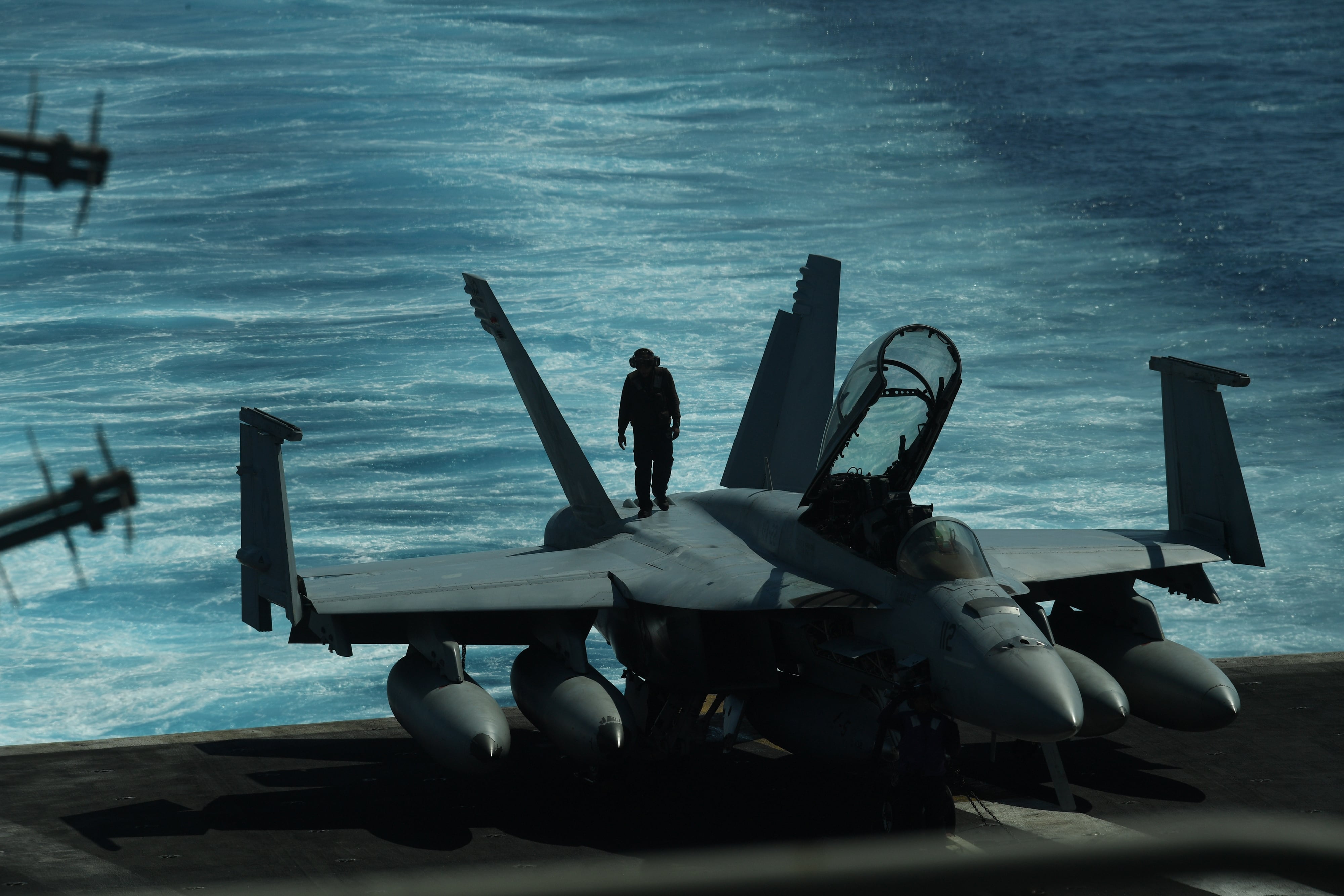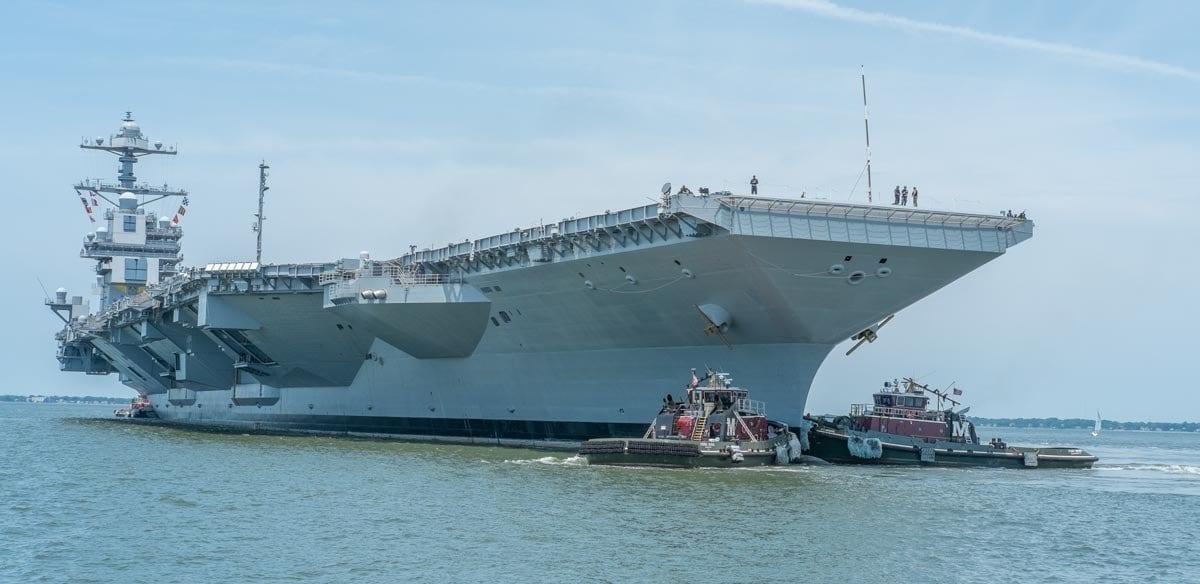WASHINGTON — As questions continue to swirl about the vulnerability and reach of aircraft carriers, Congress has gutted funding for the U.S. Navy’s research effort into a next-generation fighter to replace the relatively limited-range F/A-18 Super Hornet. Experts say the move could decide the continued relevance of the aircraft carrier in the 21st century.
The Navy planned to quadruple funding for research and development of the so-called F/A-XX, which was just $5 million in 2019, with most of the increase going toward research into a “Next Generation Advanced Engine effort,” according to the Navy’s budget submission. The effort was fully authorized in the National Defense Authorization Act, but a conference of House and Senate appropriators cut the engine research entirely, saying it was “early to need.”
The Navy’s budget request asked for $20.7 million, but Congress ultimately appropriated $7.1 million, a 66 percent cut. Congress sent the bill to the president Thursday, who was expected to sign it.
In May, Defense News reported that the effort to develop a system or family of systems to replace the shorter-range F/A-18 Super Hornet is a do-or-die effort that will determine if aircraft carriers remain relevant into the 21st century or will go the way of the chariot and battle elephant.
RELATED

As the U.S. pivots away from small wars toward squaring off with peer adversaries like China and Russia, the carrier is finding itself outranged by investments in long-range anti-ship cruise missiles such as China’s DF-21. And while there are mounds of commentary dedicated to the carrier’s irrelevance now that there is a missile with the range to challenge it, the U.S. Navy hasn’t been ready to give up.
In two separate op-eds in Defense News this year, current and former senior Navy officials, including from two retired four-star fleet commanders, defended the current program of fielding supercarriers, even in the face of Chinese and Russian threats.
“Carriers remain relevant and potent year after year and decade after decade because they are adaptable platforms in which flexible payloads deploy,” wrote Naval Air Force Atlantic Commander Rear Adm. Roy Kelley. “Carrier air wings evolve, incorporating improved and revolutionary aircraft like the unmanned MQ-25 Stingray that first flew last week. The weapons carried by those aircraft evolve even faster, keeping carrier strike groups dominant over realized and potential threats.”
Rescue efforts
But rescuing the carrier from history’s graveyard of superseded military technologies will require an urgent intervention and funding to execute the kind of air wing evolution Kelley called for. The Navy was planning to ramp up funding every year throughout the five-year budget projections, with funding peaking at $372 million in 2024, the final out year in the 2020 budget.
The Navy said in its budget submission that the funding this year was directed at maturing technologies and reducing risk in the acquisition process.
The requested funds would go to “Support Technology Maturation and Risk Reduction (TMRR) acquisition planning and execution,” the budget read. “Define TMRR propulsion and power system requirements, security construct and execution plan. Conduct in-house performance analysis and requirements refinement. [And] initiate TMRR development efforts to include engine, power and thermal systems design, refined cycle definitions and performance analysis.”

Inside the U.S. Air Force’s corridors in the Pentagon, that service is mounting an all-out research and development effort for its next fighter aircraft.
By way of comparison, the Air Force requested $1 billion in funding for its Next Generation Air Dominance program, but saw a relatively minor 10 percent cut from appropriators that was cited as a “classified adjustment.”
Bob Work, former Navy undersecretary and deputy defense secretary, told Defense News in May that the F/A-XX is the program the Navy needs to get range back onto the flight deck, which experts tend to agree is imperative. And if they’re going to do it right, they should look to unmanned platforms, Work said.
“The focus should be on the F/A-XX. If you really want range, that has to be the platform you are shooting for,” Work said. “Because with the Navy buying the F-35Cs, and the Marine [Corps] buying the F-35Bs and the Navy buying the Block III Super Hornet, you are not going to be able to afford two or three programs. So the F/A-XX is the one you need to focus on. And if the analysis shows you need range, that points to unmanned.”
Total overhaul
A study released earlier this year by the Center for Strategic and Budgetary Assessments called for a total overhaul of the carrier air wing, starting with fully committing to the MQ-25 Stingray. The autonomous refueling tanker, according to the study, should be able to drag a limited number of Super Hornets out to ranges that make effective a new kind of operations concept against Chinese and Russian threats.
If the Navy wants to counter China’s anti-ship cruise missiles and increasing naval capabilities, it must resurrect the Cold War-era “outer-air battle” concept, which focused on longer-range aircraft to counter Russia’s bombers. However, instead of fighting at 200-plus nautical miles, the air wing will have to fight at 1,000 nautical miles, the study found.
The carrier air wing of the future must also to be able to hunt submarines (serving as a replacement for the S-3 Viking aircraft); provide surveillance and targeting; and destroy ships and land targets with standoff weapons, all while fighting at nearly double the range of today’s air wing, according to the study, which was led by retired submarine officer and analyst Bryan Clark.
“The air wing of the future is going to have to be focused less on attacking terrorist training camps and huts in Syria, and more focused on killing ships and submarines at sea — dealing with naval capabilities and island-based littoral capabilities,” Clark said in a telephone interview. “Those are the challenges: Range and the mission set is changing.”
In other words, the entire air wing, both the range at which it can fight and the missions it is set up to execute, must be completely overhauled.
RELATED

In the study, Clark agreed with Work’s point about the need for unmanned fighters on deck and called for an unmanned combat air vehicle, or UCAV, with a range of up to 3,000 nautical miles without refueling and the ability to perform missions — from anti-submarine and electronic warfare to anti-surface and strike.
But the study also called for retaining a manned fighter for command-and-control capabilities in environments where communications are jammed or nonexistent, Clark said.
“There is still going to be a need for manned fighters to do close-air support, but mostly to do command and control of other platforms that are perhaps unmanned inside a comms-denied environment,” Clark said. “So you send some loitering missiles or you send UCAVs up forward; you would expect them to be managed by someone who is able to maintain comms with them. That would be a human in a fighter that is able to remain close enough to them to stay in comms.”
David B. Larter was the naval warfare reporter for Defense News.








